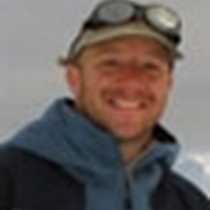Bilbao, At Sea
Buenos Dias! With an early wake up call from our Expedition Leader Tom Ritchie and a quick breakfast, we emerged from the ship to a beautiful sunrise on the pier of Bilbao, Spain. Through colorful morning hues of pink and orange, we rode our tour buses past the shipyards and housing complexes of this waking, industrial city of Spain. Located in a Basque region on the Nervion River, about eight miles upstream from the Bay of Biscay, Bilbao is the main commercial center and chief seaport of northern Spain. After a boom of iron and steel production fizzled out, the city went into a depression; however the city has since been successfully re-awakened, especially as a cultural center for art and modernization. And our destination, one of the Guggenheim Foundation's art museums, has been one of the largest contributors to the success of this town. This branch museum, designed by architect Frank O. Gehry, was a work of art itself. The building dominates the city landscape down by the Nervion River, and its shape takes on crazy, metallic swoops and angles, with bonus curves and points made of glass and stone. From the outside, we caught glimpses of modern art to stretch our imagination, including a giant spider sculpture and a two-story high puppy dog made of thousands of colorful flowers.
Accompanied by a patrol of red-jacketed curators to keep us in line, we were guided through the vast, spacious halls of the museum to see the interesting art works of artists such as Juan Muñoz and Richard Serra. The Muñoz collection included a piece called "Many Times" that consisted of a room full of smiling grey Asian men seemingly enjoying each other's company and ignoring everyone else. Its intention was to make the viewer feel left out in a crowded, non-inclusive world. We also walked through a spiral maze piece produced by Richard Serra called "Torqued Spiral (Closed Open Closed Open Closed)" from his collection called The Matter of Time. As we walked through the giant spiral, the walls produced a peculiar sensation of motion, designed to represent a progression and passage of time. Amazingly, time passed as we passed through this passage, but we emerged amazed and that's what counted, making the motion of the walls time well spent.
After surveying the interesting, spacious exhibits of the Guggenheim, we rode back to the National Geographic Endeavour for a fine afternoon at sea. Our historians David Barnes and Ron Suny gave terrific, informative lectures about Spain and Portugal, between which we had a successful sighting of some pilot whales and a tasty tea time snack of Swedish pancakes.
Buenos Dias! With an early wake up call from our Expedition Leader Tom Ritchie and a quick breakfast, we emerged from the ship to a beautiful sunrise on the pier of Bilbao, Spain. Through colorful morning hues of pink and orange, we rode our tour buses past the shipyards and housing complexes of this waking, industrial city of Spain. Located in a Basque region on the Nervion River, about eight miles upstream from the Bay of Biscay, Bilbao is the main commercial center and chief seaport of northern Spain. After a boom of iron and steel production fizzled out, the city went into a depression; however the city has since been successfully re-awakened, especially as a cultural center for art and modernization. And our destination, one of the Guggenheim Foundation's art museums, has been one of the largest contributors to the success of this town. This branch museum, designed by architect Frank O. Gehry, was a work of art itself. The building dominates the city landscape down by the Nervion River, and its shape takes on crazy, metallic swoops and angles, with bonus curves and points made of glass and stone. From the outside, we caught glimpses of modern art to stretch our imagination, including a giant spider sculpture and a two-story high puppy dog made of thousands of colorful flowers.
Accompanied by a patrol of red-jacketed curators to keep us in line, we were guided through the vast, spacious halls of the museum to see the interesting art works of artists such as Juan Muñoz and Richard Serra. The Muñoz collection included a piece called "Many Times" that consisted of a room full of smiling grey Asian men seemingly enjoying each other's company and ignoring everyone else. Its intention was to make the viewer feel left out in a crowded, non-inclusive world. We also walked through a spiral maze piece produced by Richard Serra called "Torqued Spiral (Closed Open Closed Open Closed)" from his collection called The Matter of Time. As we walked through the giant spiral, the walls produced a peculiar sensation of motion, designed to represent a progression and passage of time. Amazingly, time passed as we passed through this passage, but we emerged amazed and that's what counted, making the motion of the walls time well spent.
After surveying the interesting, spacious exhibits of the Guggenheim, we rode back to the National Geographic Endeavour for a fine afternoon at sea. Our historians David Barnes and Ron Suny gave terrific, informative lectures about Spain and Portugal, between which we had a successful sighting of some pilot whales and a tasty tea time snack of Swedish pancakes.




